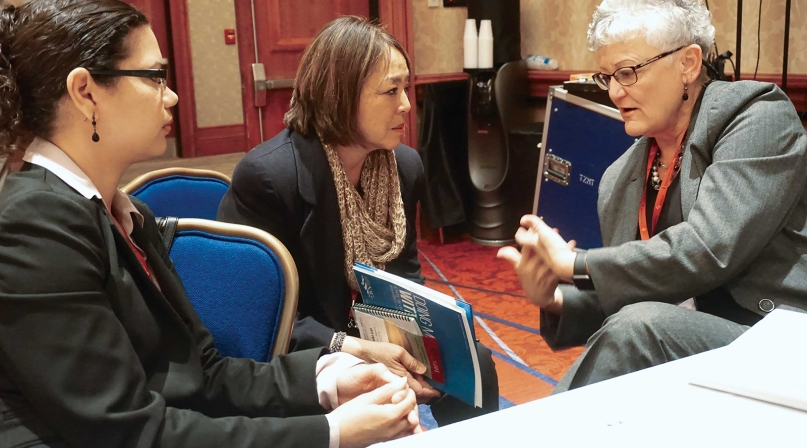NACo members discuss strategies to engage Congress
Author
Upcoming Events
Related News

Focus on stories, rather than statistics while talking to members of Congress, help them look good
Local elected officials have much greater potential to engage members of Congress than everyday constituents, due to their prominence and public office. But, to effectively advocate on behalf of their constituents, county officials must make sure they get the most out of their face time with members of Congress.
This is where Bradford Fitch comes in.
Fitch, a former Capitol Hill staffer and current president and CEO of the Congressional Management Foundation, now spends his time breaking down the barriers between Congress and constituents. During the 2017 NACo Legislative Conference, he spent extensive time working with NACo members to ensure their county got noticed in Congress.
Having an effective meeting
Senators and House members typically have upwards of 12 meetings per day, and their staffers usually have another 12–15. Since you will be one of many faces the lawmaker sees, use the short time to make sure you are the representative’s most memorable meeting of the day.
Fitch told county officials that bringing an effective story into their meeting to illustrate a point does far more than any spreadsheet full of facts and figures could.
“Telling a story well is the difference between persuading someone and not persuading someone,” Fitch explained. “The more people feel immersed in a story, the more likely they are to change their beliefs.”
More than anything, a message to a lawmaker should be short and sweet. In the 1980s, the average American attention span was 22 seconds, Fitch explained. But today, the average attention span is 2.8 seconds, due to the prevalence of technology and social media. Compare that to a goldfish, which has an attention span of nine seconds.
Here’s a step-by-step guide to crafting your message in a way that will grab your representative’s ear, as created by both NACo members and Fitch:
- Begin your story with the end in mind. Nothing is more boring than a meandering tale with no purpose. Everything you say should relate to your ending.
- The first sentence should make the lawmaker want to know more about whatever you’re talking about, but also show context and establish what’s at stake.
- As you tell your story, illustrate the conflict by playing up the role of the underdog. Your overall goal may be to get more funding, but if you can involve the lawmaker’s heartstrings and not just their wallets, you are more likely to succeed.
- Remember that 2.8-second attention span? Include some sort of surprise for the legislator to re-engage them in the story. Throw a wrench in the plotline that completely changes perspective and adds depth.
- Conclude with a “we can win” moment and show the lawmaker how they can be a part of this policy victory. Members of Congress and senators love to be involved in legislation that makes a difference in their district, especially if they don’t have to put too much effort into it. Show the lawmaker that your local government already has done 90 percent of the work and you just need their help to push that 10 percent over the finish line.
Holding a memorable event in your district
Every member of Congress goes back to their district about 40 times per year, so there are multiple opportunities to attract your senator or House member to an event.
When scheduling events back in their district, members first and foremost value things that make them look good in the public eye -- whether that means a great photo op wearing a hard hat, an event with local children or a high-stakes policy discussion with local experts. Make sure the lawmaker feels like the event is mutually beneficial; this includes minimizing the risks of the lawmaker looking bad. For example, if there’s a high risk of angry constituents firing off questions about a controversial matter, the lawmaker will probably decline the invite.
Lawmakers, and the schedulers who make their daily agendas, prefer events that are narrowly focused, such as a factory tour or a talk about a specific healthcare policy, so the lawmaker can prepare and look their best.
Prior to the event, provide the congressional staff with as much information as possible about who will be in attendance, the layout of the space, the agenda and exact time commitments. Make sure to make logistics clear and be as specific as possible. Members of Congress usually don’t take more than 30 minutes for an event, so try not to take up too much of their time.
Once a scheduling request is received, it is reviewed by the member’s scheduler, then if approved by the scheduler, it will be reviewed by senior staff for final approval. An event could also be marked as “tentative,” depending on how crucial staffers see the invitation.
Members of Congress get many requests every day, so it’s extremely important to follow up and be persistent with the scheduling director.
But at the same time, it’s important to be patient as these requests may take a long time to process.
After the event takes place, it is most important to follow up by writing thank-you notes, sharing the good news and evaluating how it went. Finally, after the lawmaker attends your event, write a letter to the editor of the local newspaper thanking them for being there.
“That letter will be read by your member of Congress,” Fitch said. “I absolutely guarantee it.”
Attachments
Related News

House passes legislation to increase the Crime Victims Fund
On January 12, the House passed the Crime Victims Fund Stabilization Act (H.R. 909) by a voice vote.

Federal district court issues ruling preventing the federal government from imposing immigration compliance mandates on grant recipients
On November 4, a federal judge in Rhode Island ruled that the U.S. Department of Transportation cannot condition federal grant funding on a recipient’s cooperation with federal immigration enforcement efforts.
